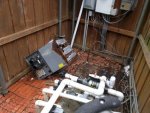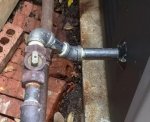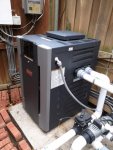- Feb 25, 2013
- 23
My Jandy LT heater needs to be replaced. I want to take on this project myself, but I need a little guidance from the experts.
My pool is 18,000g with a small attached spa. It has an AquaPure chlorine generator that is controlled by a Aqualink RS system. I have a Pentair VS filter pump, and a booster that drives a Polaris.
I'm looking at a Jandy LRZ Legacy 250K BTU, natural gas model with electronic ignition. I think some models have manual controls, and some have digital.
Question #1: My current heater has manual controls, and is activated by an Aqualink RS system. It has a control wire going to the heater control board with two wires, one black, one white (furthest left in picture below). Will a new Jandy LRZ Legacy be controlled in the exact same way? I want to avoid a situation where I need to reprogram or mess with the Aqualink system.
Question #2: If a new heater will not be controlled the same way, is reprogramming the Aqualink RS system something that I can accomplish myself? I'd consider myself to be fairly mechanically inclined, and very technically inclined (I work in IT), so I can probably get through it with assistance, but my concern is this: A few years ago, my pool contractor had to "upgrade" parts in my Aqualink system because it wasn't compatible with a new variable speed filter pump, and I worry about this same scenario with a different style heater. I don't think I could handle getting a new "board", and reprogramming the system from scratch, with the VS pump, cleaner, automated valves, and all.
Are there any other issues that I need to think about before starting this project?
My pool is 18,000g with a small attached spa. It has an AquaPure chlorine generator that is controlled by a Aqualink RS system. I have a Pentair VS filter pump, and a booster that drives a Polaris.
I'm looking at a Jandy LRZ Legacy 250K BTU, natural gas model with electronic ignition. I think some models have manual controls, and some have digital.
Question #1: My current heater has manual controls, and is activated by an Aqualink RS system. It has a control wire going to the heater control board with two wires, one black, one white (furthest left in picture below). Will a new Jandy LRZ Legacy be controlled in the exact same way? I want to avoid a situation where I need to reprogram or mess with the Aqualink system.
Question #2: If a new heater will not be controlled the same way, is reprogramming the Aqualink RS system something that I can accomplish myself? I'd consider myself to be fairly mechanically inclined, and very technically inclined (I work in IT), so I can probably get through it with assistance, but my concern is this: A few years ago, my pool contractor had to "upgrade" parts in my Aqualink system because it wasn't compatible with a new variable speed filter pump, and I worry about this same scenario with a different style heater. I don't think I could handle getting a new "board", and reprogramming the system from scratch, with the VS pump, cleaner, automated valves, and all.
Are there any other issues that I need to think about before starting this project?
Last edited:




